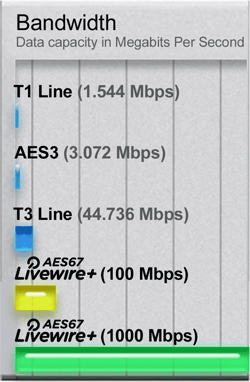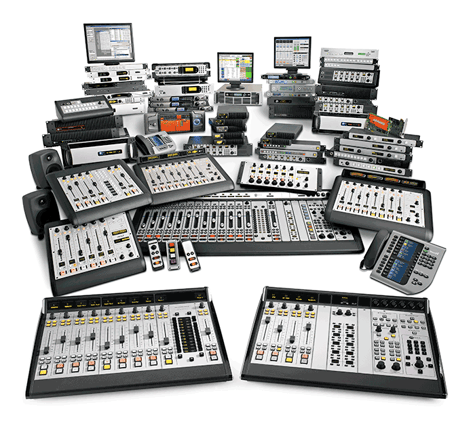Livewire+™ — Connect to More
What is Livewire+?
Livewire+ is the pioneering technology invented by the Telos Alliance to convey low-delay, high-reliability audio over switched Ethernet.
Introduced as Livewire™ in 2003, today’s Livewire+ is AES67-compliant. That means that it complies fully with the AES67-2013 Interoperability Standard, allowing AES67 devices to connect directly to Livewire+ networks and exchange audio streams. Livewire+ is also extensible, able to incorporate future AES standards when they are ratified. Livewire+ is also backward-compatible with the RAVENNA™ networking protocol.
With Livewire+, a single Ethernet cable carries real-time uncompressed digital audio, device control messages, program associated data, and even routine network traffic. An entire facility can be wired in hours, instead of weeks. All Axia Audio studio products, and most products from other Telos Alliance brands, utilize Livewire+ networking technology. Expanding or modifying your system is simple thanks to the inherent scalability and modularity of Livewire+.
Livewire+ offers a revolutionary change in how studios can be built. But at the same time, it's a natural continuation of general trends and what you already know.

How Livewire+ works
Livewire+ has an audio advertising system. Every source has a text name and numeric ID. These are transmitted from source devices to the network. Devices that play audio build lists of all available sources from which users can select. Using Telos Alliance xNode audio interfaces, you enter the names of your input sources via any PC with a web browser. With playout PCs running the Axia AoIP Driver, you open a configuration window.
A sophisticated phase-locked loop clocking system allows Livewire+ to use very small buffers for least latency and ensures that audio channels remain time-aligned (as needed for multiple mics in a studio or for TV surround-sound mixing.)Livewire+ networks employ two types of audio streams. Livestreams have small, frequent packets optimized for live audio that requires very low (circa1 ms.) delay, for microphones and headphone audio. Standard Streams are also real-time streams, but with bigger packets, and are used for audio streams which don't require super-low latency - like audio from CD players, or that exchanged with automation system PCs. Devices that connect to Axia networks can transmit and receive both stream types; the user selects which type to generate when a device is initially configured.
Converged Networks

An Ethernet network used for Livewire+ audio can also be shared with other data transmissions, such as file transfers and web browsing. An Ethernet system with a switch at the center may have a mix of audio nodes and normal servers, PCs, etc., because the Ethernet switch directs traffic only to where it is needed.
Even on a single link, traffic can be mixed because we use modern Ethernet's priority mechanism to be sure audio packets have first call on the link's bandwidth. A studio audio delivery system can use this capability to download an audio file from a server, for example, while simultaneously playing another audio file live.
Livewire+ maximizes the benefits of converged networking in the broadcast facility. Many stations using Livewire+ have computer data, telephone, audio, and control on a single network that uses computer industry standard wiring, spurring cost-efficiencies throughout the plant.
 Audio Quality
Audio Quality
A Livewire+ network is a controlled, high-speed environment, with no risk of audio drop-outs from network problems and plenty of bandwidth for many channels of high-quality uncompressed audio. We use studio-grade 48kHz/24-bit PCM encoding. Axia digital xNode audio adapters deliver 138dB of dynamic range, with less than 0.0002% THD. Even analog xNodes have 100dB dynamic range, < 0.005% THD, and headroom to +24dBu.
Livewire+ is standards-based
Since the very beginning, The Telos Alliance has based its AoIP networking technologies on standards. IP (Internet Protocol), the networking standard that is the underpinning of nearly all critical business networks (and of the Internet itself) is the basis for Livewire+ AoIP.
As charter members of the AES X.192 Working Group, we helped define the AES67 standard — and became the first broadcast manufacturer to become AES67 compliant.
Livewire+ is so standards-based, in fact, that your audio can even be played by PC media players that support standard protocols and uncompressed PCM audio. The Internet’s IP standard for streaming media, called RTP/IP, is used for standard audio streams. RTP stands for Real-Time Protocol. It's the Internet’s standard way to transport streaming audio and video, just as TCP/IP is the standard for general data. Since we adhere to Internet standards,
 The Gold Standard
The Gold Standard
In the decade since the introduction of Livewire+, broadcasters have adopted it at an exponential rate; AoIP has become the new standard for broadcast facilities.
Consider these facts:
There are over 6,000 studios worldwide built with Livewire+.
More than 5,500 networked Axia consoles are at work daily.
Over 100 Livewire+ Partner companies provide compatible hardware and software products.
There are more than 60,000 individual Livewire+ devices in the field.
Livewire+ is fully compliant with the AES67 Interoperability Standard.
Impressive, no? But there are even more exciting things in the future. The Telos Alliance, with one of the largest R&D groups in broadcast, is fully committed to AoIP interoperability. We’ve been proponents of open standards since Day 1, freely sharing our technology with interested Hardware and Software Partners. We were charter, supporting member of the X.192 Working Group that defined the AES67 standard, and as founding members of the Media Networking Allliance, are actively engaged in work to promote and enhance standards-based AoIP networking.
Frequently-Asked Questions about Livewire+
I hear you’ve renamed Livewire to Livewire+™. What does this mean?
I was told that Livewire+ is actually the basis for AES67. Is that true?
As part of the X.192 working group, Axia and the Telos Alliance worked with other companies to help define the standard. During this process, we made available, at no charge, parts of our own patented technology to help speed development of the standard.
Does that mean that Livewire+ actually is AES67?
Not exactly! What it does mean is that much of Livewire+ is the basis for AES67. You might say that AES67 has Livewire+ in its DNA.
So what does the “plus” in Livewire+ mean, exactly?
It means three things.
- Livewire+ is completely AES67-compliant. Compliant means that Livewire+ fully complies with all parts of the AES67 standard.
- Livewire+ is future-proof, because it’s extensible. Future standards (such as might come from the AES X.210 group) can be included once ratified; Livewire+ can never become obsolete.
- Choosing Livewire+ means you don’t have to wait for interoperability. Livewire+ represents the world’s largest grouping of AoIP technology partners – over 80 software and hardware manufacturers and integrators whose products work together, with integrated audio, source discovery, logic control and data — right now, without the need to wait for additional standards.
You say Livewire+ is “AES67-compliant”. Other companies say their gear is “AES-67 compatible.” What’s the difference?
What does the AES67 standard contain?
According to Mark Yonge, AES Standards Manager:
“This standard defines an interoperability mode for transport of high-performance audio over networks based on the Internet Protocol. For the purposes of the standard, high-performance audio refers to audio with full bandwidth and low noise. These requirements imply linear PCM coding with a sampling frequency of 44,1 kHz and higher and resolution of 16 bits and higher. High performance also implies a low-latency capability compatible with live sound applications. The standard considers latency performance of 10 milliseconds or less. This standard provides comprehensive interoperability recommendations in the areas of synchronization, media clock identification, network transport, encoding and streaming, session description and connection management.”
(Reference: http://www.aes.org/standards/blog/2013/9/aes67-2013-audio-over-ip-130911)
If AES67 does all this, why does Livewire+ exist?
Good question! The AES67 specification is a good start toward interoperability, but is actually a subset of the many functions that Livewire+ performs today. When we developed Livewire back in the early 2000s, we had to synthesize the critical links between networking technologies, because a full standard didn't exist yet — and earlier networked audio systems lacked critical functionality. We developed a way to make GPIO logic “ride along” with the audio streams, and a way for available sources to “advertise” their availability to all the networked devices that operators might want to use.
We also recruited partner companies whose products are respected and widely-used in the radio industry. Then we shared our technology with them, so that station engineers could connect as many audio devices as possible directly to their audio network. Not only is native connectivity an elegant solution, it reduces total system costs by removing the need for those extra I/O devices.
Ten years later, the industry finally adopted a standard for AoIP audio transport in AES67. The goal is for every studio audio device to eventually click together with CAT-5 and share audio. But along with that shared audio, there’s a whole world of other functionality that broadcasters expect — like device start/stop functions, monitor mutes, on-air tallies, the ability to control peripherals from the console, the ability to know when an audio source is live and ready for air, the ability for playout systems to control fader on/off functions and more. Those are functions that AES67 alone doesn’t provide for, but Livewire+ does. And now that the first AES67 devices are appearing in the marketplace, broadcasters have quickly found that they also need to support those additional capabilities in order to provide an integrated control experience for the user — otherwise they’re no better than AES3 streams, with serial GPI cables running alongside.
With Livewire+, you can have your cake and eat it, too. Over 5,500 Livewire+ powered consoles and 60,000 devices are in use around the world daily. Livewire+ provides audio with integrated control and discovery right now. And, because Livewire+ is extensible, broadcasters using it can enjoy its rich control architecture and integration with over 80 partner products, exchange audio with AES67 devices, and be assured that when an AES standard for control is ratified, it will be part of Livewire+ as well. Livewire, the original AoIP technology for broadcast is still on the leading edge, and is the most successful by a wide margin.
Does Livewire+ still work with RAVENNA?
Yes. Axia and RAVENNA have been partners for several years, both working together to define the AES67 standard. Going forward, standards-based Livewire+ will continue to be backward-compatible with the RAVENNA protocol.
The Telos Alliance and ALCNetworX were a big part of the X.192 project. Isn’t AES67 just a synthesis of those two systems?
Not at all. The X.192 Task Group consisted of over 100 members from a wide variety of equipment manufacturers — including some who are direct competitors. It wasn’t a “rubber-stamp” project! AES67 is the result of 3 years of collaboration by these many contributors, ensuring use of the best ideas, no matter where they originated.
You say that Axia introduced AoIP to broadcast in 2002, and you’ve got 5,500 studios on-air. So why is AES67 even needed?
When Steve Church, Greg Shay and their team were developing Livewire, they had to invent tech that didn’t exist before. One critical piece of tech was network clock sync. Problem was, the Ethernet standard in place at the time had no criteria for high-precision time-synched audio.
Why is this so critical? As Telos Alliance Chief Science Officer Greg Shay explained in his excellent paper “Taking the ‘Sting’ Out of Evolving Digital Audio Networks” (presented at NAB 2013 and downloadable from TelosAlliance): “Accurate timebase recovery is directly related to, and essential for, low latency (low delay) of the audio going over the network.”
In other words, if you want networked, real-time, broadcast quality audio without jitter and delay, you’ve got to have all network devices synchronized to a network master clock. So we invented the first distributed high-precision clocking system for Ethernet, and debuted it in Livewire.
Although we have always been happy to share our tech with software and hardware manufacturers, other, open methods of Ethernet clock sync emerged, one of which became the IEEE-1588 synchronization standard — which is an integral part of AES67.
I need new studios. Should I wait to purchase equipment until all the manufacturers adopt AES67?
Not unless you’re prepared to wait quite a while. Implementing a new standard always takes time, as manufacturers adapt existing products, design new ones, and release software updates.
In the meantime, Livewire+, with over 5,500 studios on-the-air worldwide, is working today, and has a roadmap for future compatibility of existing hardware. This assurance means that the studio you build with Livewire+ today will be compatible with future AES standards for AoIP — your studio gear can’t become obsolete.
What changes, if any, will be required for my existing Livewire network to support AES67?
Compliance with AES67 is a part of the latest software present in Axia analog, AES/EBU, microphone and mixed-signal xNode AoIP interfaces, and Linear Acoustic SDI xNode devices. If you have these products already, simply download the update packages and apply them using a standard Web browser and PC, or use Axia iProbe software to “push” the update to your devices en masse. After this update, you’ll be able to generate and consume native AES67 streams.
And of course, the Telos Alliance plans to implement AES67 capability within more products going forward — your assurance that studios built with Livewire+ are future-proof.
Will I need to change my Ethernet switches to work with Livewire+ and AES67?
No! Livewire+ and AES67 coexist on the same switch fabric.
What are the advantages of specifying Partner equipment that works with Livewire+, versus gear that supports AES67 alone?
The whole idea of AES67 is to open up more equipment choices when you buy. The AES67 standard enables equipment from a variety of manufacturers to exchange “agnostic” audio streams without fuss. However, the AES67 specification provides interoperability standards for audio only — not for control or data exchange. Nor does AES67 equipment have the ability to automatically discover available audio, and present it to the operator for use. Most engineers agree that these abilities are a big part of the AoIP advantage. So, if control and source advertising is important to you, choosing equipment with Livewire+ capability will definitely be to your advantage.
